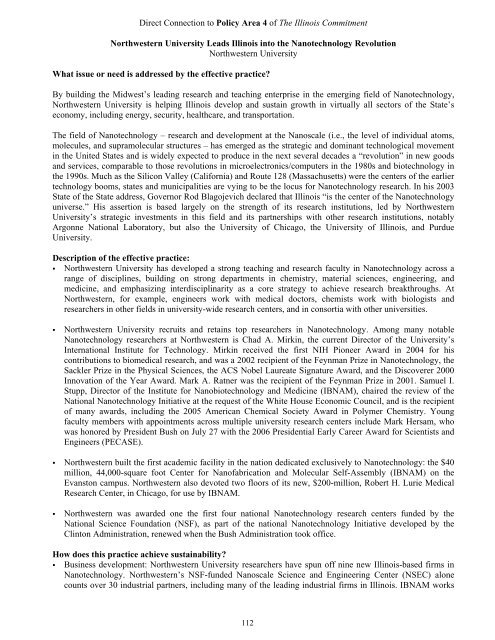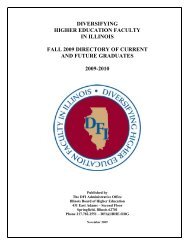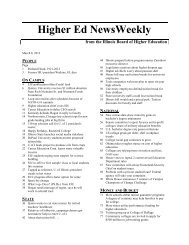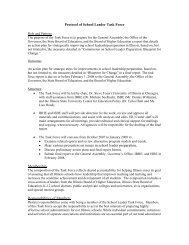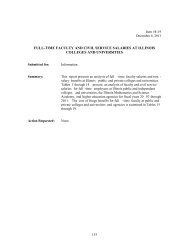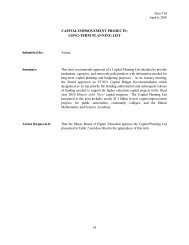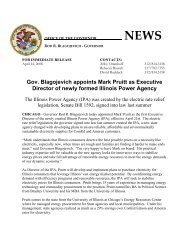Title of Effective Practice: - California Postsecondary Education ...
Title of Effective Practice: - California Postsecondary Education ...
Title of Effective Practice: - California Postsecondary Education ...
Create successful ePaper yourself
Turn your PDF publications into a flip-book with our unique Google optimized e-Paper software.
Direct Connection to Policy Area 4 <strong>of</strong> The Illinois Commitment<br />
Northwestern University Leads Illinois into the Nanotechnology Revolution<br />
Northwestern University<br />
What issue or need is addressed by the effective practice?<br />
By building the Midwest’s leading research and teaching enterprise in the emerging field <strong>of</strong> Nanotechnology,<br />
Northwestern University is helping Illinois develop and sustain growth in virtually all sectors <strong>of</strong> the State’s<br />
economy, including energy, security, healthcare, and transportation.<br />
The field <strong>of</strong> Nanotechnology – research and development at the Nanoscale (i.e., the level <strong>of</strong> individual atoms,<br />
molecules, and supramolecular structures – has emerged as the strategic and dominant technological movement<br />
in the United States and is widely expected to produce in the next several decades a “revolution” in new goods<br />
and services, comparable to those revolutions in microelectronics/computers in the 1980s and biotechnology in<br />
the 1990s. Much as the Silicon Valley (<strong>California</strong>) and Route 128 (Massachusetts) were the centers <strong>of</strong> the earlier<br />
technology booms, states and municipalities are vying to be the locus for Nanotechnology research. In his 2003<br />
State <strong>of</strong> the State address, Governor Rod Blagojevich declared that Illinois “is the center <strong>of</strong> the Nanotechnology<br />
universe.” His assertion is based largely on the strength <strong>of</strong> its research institutions, led by Northwestern<br />
University’s strategic investments in this field and its partnerships with other research institutions, notably<br />
Argonne National Laboratory, but also the University <strong>of</strong> Chicago, the University <strong>of</strong> Illinois, and Purdue<br />
University.<br />
Description <strong>of</strong> the effective practice:<br />
• Northwestern University has developed a strong teaching and research faculty in Nanotechnology across a<br />
range <strong>of</strong> disciplines, building on strong departments in chemistry, material sciences, engineering, and<br />
medicine, and emphasizing interdisciplinarity as a core strategy to achieve research breakthroughs. At<br />
Northwestern, for example, engineers work with medical doctors, chemists work with biologists and<br />
researchers in other fields in university-wide research centers, and in consortia with other universities.<br />
• Northwestern University recruits and retains top researchers in Nanotechnology. Among many notable<br />
Nanotechnology researchers at Northwestern is Chad A. Mirkin, the current Director <strong>of</strong> the University’s<br />
International Institute for Technology. Mirkin received the first NIH Pioneer Award in 2004 for his<br />
contributions to biomedical research, and was a 2002 recipient <strong>of</strong> the Feynman Prize in Nanotechnology, the<br />
Sackler Prize in the Physical Sciences, the ACS Nobel Laureate Signature Award, and the Discoverer 2000<br />
Innovation <strong>of</strong> the Year Award. Mark A. Ratner was the recipient <strong>of</strong> the Feynman Prize in 2001. Samuel I.<br />
Stupp, Director <strong>of</strong> the Institute for Nanobiotechnology and Medicine (IBNAM), chaired the review <strong>of</strong> the<br />
National Nanotechnology Initiative at the request <strong>of</strong> the White House Economic Council, and is the recipient<br />
<strong>of</strong> many awards, including the 2005 American Chemical Society Award in Polymer Chemistry. Young<br />
faculty members with appointments across multiple university research centers include Mark Hersam, who<br />
was honored by President Bush on July 27 with the 2006 Presidential Early Career Award for Scientists and<br />
Engineers (PECASE).<br />
• Northwestern built the first academic facility in the nation dedicated exclusively to Nanotechnology: the $40<br />
million, 44,000-square foot Center for Nan<strong>of</strong>abrication and Molecular Self-Assembly (IBNAM) on the<br />
Evanston campus. Northwestern also devoted two floors <strong>of</strong> its new, $200-million, Robert H. Lurie Medical<br />
Research Center, in Chicago, for use by IBNAM.<br />
• Northwestern was awarded one the first four national Nanotechnology research centers funded by the<br />
National Science Foundation (NSF), as part <strong>of</strong> the national Nanotechnology Initiative developed by the<br />
Clinton Administration, renewed when the Bush Administration took <strong>of</strong>fice.<br />
How does this practice achieve sustainability?<br />
• Business development: Northwestern University researchers have spun <strong>of</strong>f nine new Illinois-based firms in<br />
Nanotechnology. Northwestern’s NSF-funded Nanoscale Science and Engineering Center (NSEC) alone<br />
counts over 30 industrial partners, including many <strong>of</strong> the leading industrial firms in Illinois. IBNAM works<br />
112


